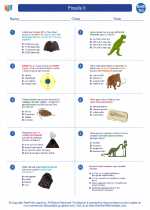Fossils II -> blood
Blood
Blood is a specialized bodily fluid that circulates in the cardiovascular system, delivering essential substances such as nutrients and oxygen to the cells and carrying waste products away from the cells. It is composed of a fluid portion called plasma and various cellular components, including red blood cells, white blood cells, and platelets.
Composition of Blood
- Plasma: Makes up about 55% of the total blood volume and consists of water, proteins, electrolytes, hormones, and waste products.
- Red Blood Cells (Erythrocytes): Responsible for transporting oxygen from the lungs to the body's tissues and carbon dioxide from the tissues to the lungs. They constitute about 45% of the blood volume.
- White Blood Cells (Leukocytes): Play a key role in the body's immune response, defending against infectious agents and foreign substances. They make up a very small percentage of the total blood volume.
- Platelets: Essential for blood clotting and the formation of blood clots to prevent excessive bleeding. They are also present in a small percentage within the blood.
Functions of Blood
Blood serves several critical functions in the body, including:
- Transporting oxygen, nutrients, and hormones to the body's cells.
- Removing waste products, such as carbon dioxide and urea, from the body's cells.
- Regulating body temperature and maintaining pH balance.
- Defending against infections and foreign invaders through the action of white blood cells and antibodies.
- Preventing excessive bleeding by forming blood clots.
Blood Types
Human blood is classified into different blood types based on the presence or absence of certain antigens and antibodies. The most common blood type classification system is the ABO system, which categorizes blood into four main types: A, B, AB, and O.
Each blood type also has a positive or negative Rh factor, resulting in eight possible blood types: A+, A-, B+, B-, AB+, AB-, O+, and O-.
Study Guide
When studying blood, it's important to focus on the following key areas:
- Understanding the composition of blood, including the functions of plasma, red blood cells, white blood cells, and platelets.
- Exploring the functions of blood in the body, such as transportation, defense, and homeostasis.
- Learning about the different blood types and their compatibility for blood transfusions.
- Understanding the processes of blood clotting and the importance of maintaining the balance between clotting and bleeding.
Additionally, practical activities such as blood typing experiments and interactive simulations can be helpful in reinforcing the concepts related to blood composition and function.
Remember to review and practice multiple-choice questions, diagrams, and case studies to test your understanding of the topic.
Good luck with your studies!



